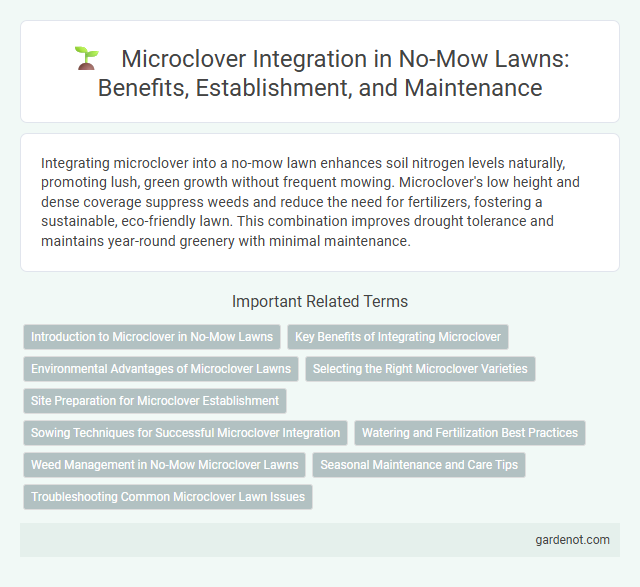Integrating microclover into a no-mow lawn enhances soil nitrogen levels naturally, promoting lush, green growth without frequent mowing. Microclover's low height and dense coverage suppress weeds and reduce the need for fertilizers, fostering a sustainable, eco-friendly lawn. This combination improves drought tolerance and maintains year-round greenery with minimal maintenance.
Introduction to Microclover in No-Mow Lawns
Microclover is a low-growing legume that integrates seamlessly with no-mow lawns, enhancing soil nitrogen levels naturally and improving drought resistance. Its dense, green foliage reduces weed growth and maintains a soft, lush appearance without frequent mowing. Incorporating microclover into no-mow lawns promotes sustainable turf health, requiring less water and fertilizer while supporting a vibrant, eco-friendly landscape.
Key Benefits of Integrating Microclover
Microclover integration enhances no-mow lawns by naturally fixing nitrogen, significantly reducing the need for synthetic fertilizers and promoting sustainable growth. Its dense, low-growing foliage improves soil health, increases drought tolerance, and maintains a lush green appearance with minimal maintenance. Microclover also suppresses weed growth effectively, providing a resilient, eco-friendly lawn solution that thrives without regular mowing.
Environmental Advantages of Microclover Lawns
Microclover integration in no-mow lawns significantly enhances soil nitrogen fixation, reducing the need for synthetic fertilizers and lowering environmental impact. Its deep-root system improves soil structure and water retention, promoting drought resistance and minimizing irrigation requirements. Microclover lawns foster biodiversity by providing habitat for beneficial insects, contributing to a healthier ecosystem.
Selecting the Right Microclover Varieties
Selecting the right microclover varieties for a no-mow lawn involves prioritizing drought tolerance and shade adaptability to ensure year-round coverage with minimal maintenance. Microclover species like Trifolium repens 'Pirate' and 'Microclover Miniclover' are well-suited for blending with turfgrass, enhancing nitrogen fixation and reducing mowing frequency. Choosing varieties with finer leaves and slower growth rates maximizes aesthetic appeal while minimizing competition with existing grass species.
Site Preparation for Microclover Establishment
Preparing a site for microclover integration requires thorough soil testing to ensure optimal pH levels between 6.0 and 7.0, fostering healthy growth. Removing existing vegetation through methods such as light tilling or herbicide application promotes better seed-to-soil contact necessary for microclover establishment. Properly amending the soil with phosphorus and potassium improves root development, enhancing the sustainability of a no-mow lawn with microclover.
Sowing Techniques for Successful Microclover Integration
Sowing microclover into a no-mow lawn requires precise seed distribution at a rate of 2 to 4 pounds per 1,000 square feet to ensure optimal coverage and growth. Proper soil preparation, including aeration and light raking, enhances seed-to-soil contact and promotes healthy establishment without disturbing existing grass roots. Timing sowing during early spring or fall leverages favorable moisture and temperature conditions, resulting in successful microclover integration and improved lawn resilience.
Watering and Fertilization Best Practices
Integrating microclover into a no-mow lawn reduces traditional watering needs by enhancing soil moisture retention through nitrogen fixation. Optimal fertilization involves using low-nitrogen fertilizers to support microclover's natural nutrient contributions while promoting drought tolerance. Consistent, deep watering once a week encourages deep root growth, improving overall lawn resilience and water efficiency.
Weed Management in No-Mow Microclover Lawns
Integrating microclover into no-mow lawns enhances weed management by increasing ground cover density, which suppresses weed seed germination and growth. Microclover's nitrogen-fixing capabilities promote healthier, more resilient turf that outcompetes invasive weeds naturally. This symbiotic approach reduces the need for chemical herbicides, supporting sustainable, low-maintenance lawn care.
Seasonal Maintenance and Care Tips
Microclover integration in no-mow lawns enhances soil nitrogen fixation, reducing fertilizer needs during spring and fall. Seasonal maintenance includes aerating the soil lightly and maintaining consistent moisture to support microclover growth and resilience. Avoid heavy mowing or dethatching to preserve microclover health and maximize benefits throughout the growing season.
Troubleshooting Common Microclover Lawn Issues
Microclover integration can sometimes lead to patchy growth or yellowing leaves due to inconsistent watering or poor soil drainage. Address these issues by maintaining consistent moisture levels and aerating compacted soil to improve root health. Regularly monitor nitrogen levels and apply appropriate fertilizers to promote vigorous, even microclover growth across the no-mow lawn.
Microclover integration Infographic

 gardenot.com
gardenot.com